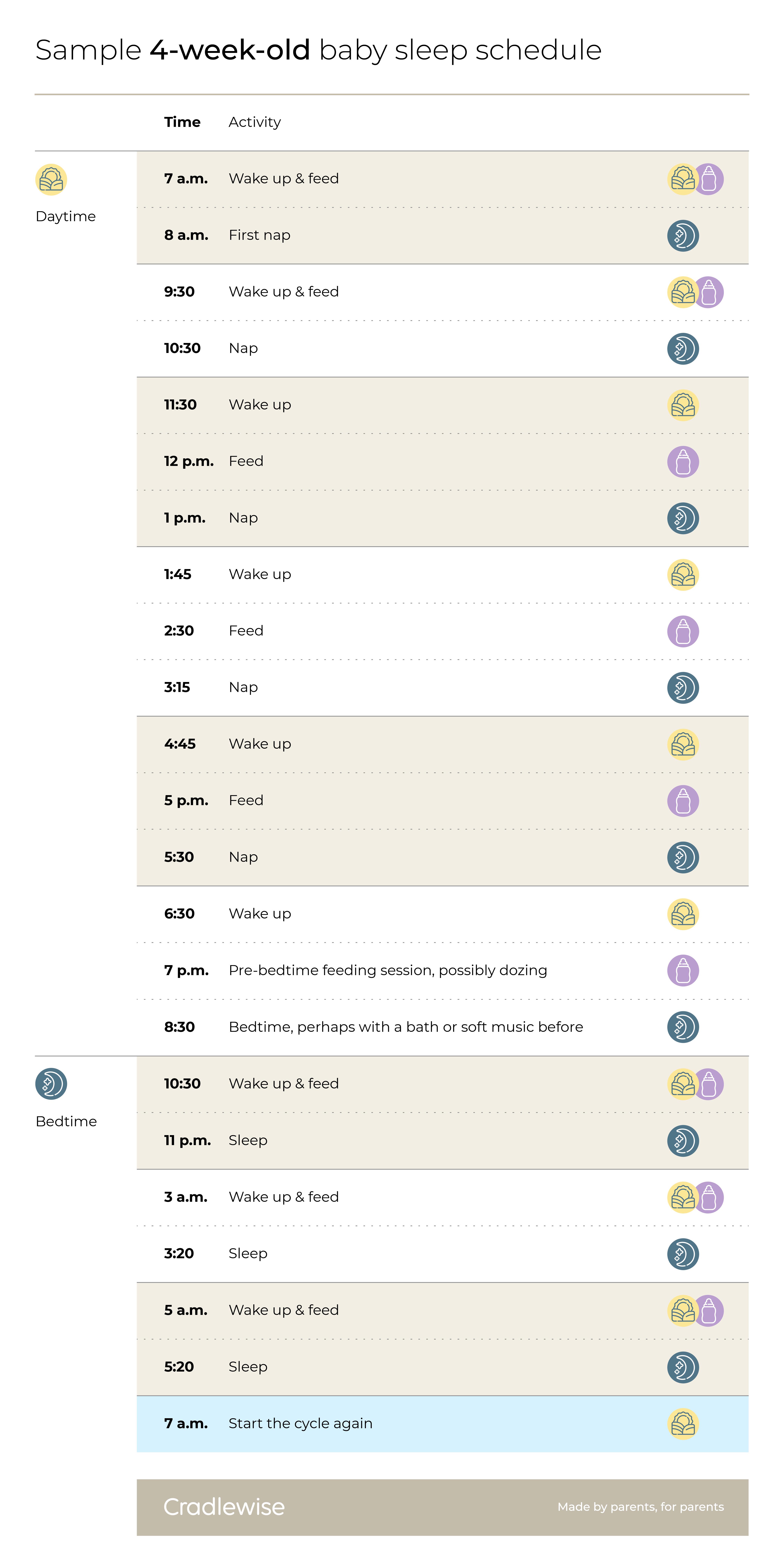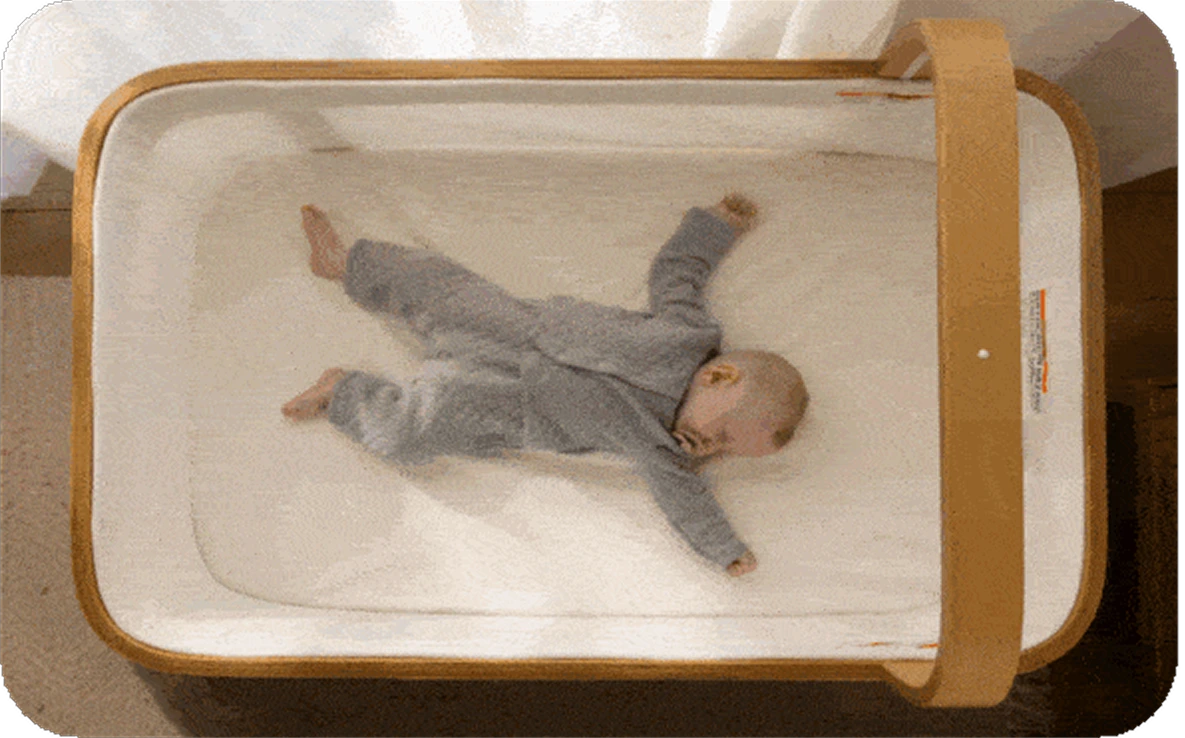
Night sleep
9.5-10 hours

Daytime naps
6-7.5 hours

Total sleep
16-17 hours
Congrats! If you’ve just welcomed a new baby into your home, you’re likely feeling both overjoyed and overwhelmed as you adjust to taking care of this tiny person’s every need—around the clock.
Most seasoned parents and caregivers look back and recall the first few months of parenting as a blur, and one of the main reasons for this is lack of sleep. Babies in their first four weeks of life have sleep patterns that can best be described as disorganized, and this can be tough to deal with at first, especially if you’ve spent the last few decades getting a solid eight hours of shuteye most nights.
Read on for science-backed information about why very young babies sleep the way they do, as well as tips and strategies for preserving your own rest and sanity.
One-month-old baby milestones for sleep
The first thing to know about month one: Babies will spend a big portion of this time asleep. The catch? It won’t be in large chunks, and because their circadian rhythms aren’t developed yet, they may mix up daytime and nighttime, which can be frustrating. They will also be waking to eat every few hours, so you’ll want to set up at least one or two cozy feeding spots stocked with parent essentials like water and snacks, earbuds, and an extra phone charger. (And if you use the wee hours to binge-watch Bridgerton, we won’t judge.)
Take comfort in the fact that as your little one’s nervous system matures, things will change and shift with time, and soon you’ll all be getting more zzzs.

💥 BLACK FRIDAY SALE 💥
Smarter Sleep for Your Baby
An award-winning crib—loved by parents, approved by experts.
0 to 24 months of use
Automatic soothing
Built-in video & sound machine
AI-powered sleep insights
Customizable soundtracks
Get 2 extra hours of sleep nightly
What’s going on in your baby’s brain?

When your baby is born, the lower part of the nervous system—meaning the spinal cord and brain stem—is well-developed. These areas control essential early behaviors such as kicking, grasping, crying, sleeping, and feeding. Brain regions such as the limbic system and cerebral cortex, which are connected to higher-level mental activities such as thinking, memory, perception, and emotion, develop more slowly, over time.
During these early weeks, you may observe that your baby’s movements are reflexive, rather than purposeful. Newborn reflexes are instinctive and may have evolved as a way to protect against perceived dangers; they also help your doctor assess how well their nervous system is developing. One example is the Moro reflex, where an infant will splay out their arms in response to a loud sound or the feeling of falling, like when you put them down in the crib on their back. In some cases, your baby might startle themselves awake. The Moro reflex usually disappears by four months of age.

Crib Notes
Did you know that Cradlewise can identify Moro reflex? It automatically starts bouncing as soon as your baby wakes up and before they start crying.
How much should a 4-week-old baby sleep?

- Total hours of sleep: During the first four weeks, you can expect your baby to be asleep for 16 to 17 hours within each 24-period. But what can feel so disorienting is that because their sleep cycles are still short, and they need to eat frequently, so they’re only asleep in small chunks of time—maybe one to two hours, or three if you’re lucky. You might also notice that they wake easily during these early weeks, and some researchers theorize that this may be an adaptive behavior to guard against SIDS (Sudden Infant Death Syndrome).
- Wake windows: If you’ve been reading up on infant sleep, you might have come across the term “wake window.” This simply means how many hours your child will be awake between stretches of sleep. Each baby is different, but they’re typically awake anywhere from 30 or 45 minutes to two hours. Since they’re also eating 8 to 12 times each day (or about every 3 hours or less), you might find that you’ll have just enough time to feed them, change their diaper and cuddle them before they’re ready for the next snoozing session. This is completely normal, and as your baby grows and gains stamina, they’ll be able to spend more time awake.
- Number of naps: During the first two months, your baby might take four to five naps during the day, sleeping anywhere from 6 to 7.5 hours. Eventually, your baby will start shifting to sleep more hours overnight, and fewer during the day until they drop to one nap.
Sample 4-week-old baby sleep schedule
Keep in mind that this is just an example and every baby has their own rhythms. Yours might sleep a longer stretch earlier in the evening after bedtime, or take a shorter nap in the morning. The beauty of Cradlewise is that it’s going to be learning your baby’s schedule right along with you, and helping soothe them back to sleep when necessary.


Newborn feeding tips
During the first month, you’ll want to be sure your baby is feeding frequently and gaining weight, which your pediatrician will help you track. Babies lose weight after they’re born, but by two weeks of age, they should have regained their birth weight.
Wondering why they seem eternally hungry? Their stomach is teeny: By day 10, it’s only the size of a ping pong ball, capable of holding a mere one to two ounces. The Mayo Clinic suggests that until your baby regains their birth weight, you should wake them to eat if they sleep longer than four hours.
- How often should a 1-month-old eat: Babies at this age need to eat anywhere from every 90 minutes to every three hours. That timing is based on when they started eating—so if you begin nursing or bottle-feeding at 10:30 a.m., know that you’ll need to start your next feed anywhere from noon to 1:30 p.m. at the very latest (usually much sooner). At first it can be helpful to log your baby’s feedings since sleep deprivation can make everyone a little forgetful. Keeping track of their feeds will also help you estimate when they might sleep, which can help you plan your day.
- How much should a 1-month-old eat: At 1 month old, babies should be eating around 4 ounces every four hours. If your baby was born prematurely, they might have different feeding requirements and might not display hunger cues such as crying, so always check with your pediatrician for guidance.
- Tip: Burping can also help ease your baby’s discomfort. If you’re breastfeeding, make it a point to burp each time you switch breasts, and if you’re bottle feeding, try to burp after every two to three ounces.
How to help support your baby’s sleep during the first month

The only “must” of the first month is to try and go with the flow, but there are some things you can try to help guide your baby toward quality sleep.
Watch your cues.
Imagine you’re a detective, and keep an eye on your baby to see when they might be hungry or tired. Signs of tiredness include eye rubbing, yawning, avoiding eye contact or fussing. Early hunger signals include bringing the hand to the mouth, lip smacking, stirring during sleep and rooting (turning the head and opening the mouth). Crying is a later sign for both hunger and tiredness, and if you wait until the wailing starts to feed or soothe your baby, they might become grumpy and have a tougher time getting resettled. Eventually, as you hone your parental intuition skills, this will become second nature: You’ll know, for example, that when your baby starts scowling and looking down towards the floor, you’ve only got a few minutes to get them settled for the morning nap.
Support circadian rhythms.
Your baby’s internal clock will develop over time, but you can help encourage them by exposing them to sunlight during the day, and keeping the bedroom dark during the evenings. (Find out how breast milk also helps develop circadian rhythm in babies.) Before bedtime, dim the lights in your home and keep your baby away from the blue light generated by electronic devices like mobile phones and computer screens. If you need to feed or change a diaper overnight, turn on only a soft light that helps you see what you’re doing.
Start with sound habits.
Your baby might be little now, but it’s never too soon to engage in healthy sleep practices. Design a soothing bedtime routine, such as a bath, massage and a story, and continue to do this so your baby associates it with going to bed. You’ll also want to aim to put your baby down drowsy but awake, so they can get used to going to sleep on their own.
Try a swaddle.
Wrapping your baby may help encourage longer sleep stretches, but it’s important to do it safely. Always put your baby down to sleep on their back, and stop using the swaddle when they start to show signs of being able to roll over since they could become trapped in a facedown position. Swaddling can also cause your baby to overheat, so make sure to monitor their temperature and keep the room between 68℉ and 72℉ (a fan can help circulate air).
Create custom sleep tracks.
Cradlewise offers a built-in sound machine with a choice of white, pink or brown noise designed to mimic what your baby got used to hearing in the womb. You can customize your own sleep tracks and even mix in the sound of a heartbeat, another soothing element.
Respect the witching hour.
Around the two-week mark, the hours from roughly 5 p.m. until bedtime can start to become especially difficult. Your baby may be cranky and want to cluster feed, or eat every 30 to 60 minutes. You might have heard about PURPLE crying, which is an acronym used to describe what babies are going through at this point in their life—the good news is, it’s perfectly normal. The acronym stands for: Peak of crying (it’s the most during month two), Unexpected, Resists soothing, Pain-like face, Long lasting (as much as five hours!) and Evening (when it tends to happen).
The good news is that this type of crying peaks at about six weeks and should ease after that. Having someone else around during this time, whether it’s a partner, paid babysitter, friend or relative, can be incredibly helpful. If you don’t have relatives nearby, you can also try out the app’s “caregiver team” functionality, so grandparents or other loved ones can also check in on your baby and commiserate or celebrate with you, depending on the day.
If your baby’s crying is really frustrating you and you’re parenting solo, put them in a safe spot like their crib, take a short break (10 minutes or less) and come back after you take some deep breaths or try something to shift your mindset like listening to a song or splashing some water on your face. Know that even if your baby cries briefly, you aren’t going to harm them or do any kind of irreparable damage.
Prioritize your own rest.
The phrase “sleep when the baby sleeps” might be the most overused parenting phrase, but for good reason. Issues with sleep deprivation have been linked to higher rates of postpartum depression. You might not be able to get your usual eight hours straight (especially if you’re breastfeeding exclusively), but you can enlist help from others: Maybe your partner can handle an overnight feeding or at least a diaper change or a friend can run errands or babysit an older sibling. And as tempting as it can be to check your to-do list or your phone when you finally have a minute to yourself, slide on a sleep mask and give yourself permission to let your chores slide and those congratulatory texts go unanswered for a bit.
More posts you might like:
Sources:
- Newborns lack circadian rhythms at birth. 2017. Nature of Science and Sleep. Infant sleep and its relation with cognition and growth: a narrative review
- Newborns and circadian rhythms. 2018. Journal of Clinical Sleep Medicine. Perspective: The Long-Term Effects of Light Exposure on Establishment of Newborn Circadian Rhythm
- A baby’s nervous system at birth. 2016. Zero to Three. How developed is the baby brain by birth?
- Description of newborn reflexes. Medline Plus. Infant reflexes
- Moro reflex is instinctive and protective. 2021. WebMD. What are newborn reflexes?
- Newborn reflexes and the maturation of the nervous system. 2020. Healthy Children.org. Movement milestones: Birth to three months
- How much do babies sleep in a day? HealthyChildren.org. Ages and stages: Sleep
- What to expect during the first month. 2019. American Academy of Pediatrics: Caring for Your Baby and Young Child from Birth to Age Five, Seventh Edition.
- Newborns and feeding patterns. 2022. Mayo Clinic. Should I wake my newborn for feedings?
- Signs of sleep readiness in infants. Johns Hopkins Medicine. Newborn sleep patterns
- Nighttime sleep-Wake Patterns. 2002. Journal of Psychology and Psychiatry. Nighttime sleep-wake patterns and self-soothing from birth to one year of age: a longitudinal intervention study
- Newborn crying peaks at six weeks. 2016. Zero to Three. Birth to three months: Your baby’s development
- By day 10, the size of a baby’s stomach is the size of a ping pong ball. USDA WIC Breastfeeding Support. How much milk your baby needs
- Sleep requirements in newborns. 2020. Sleep.org. The best sleep schedule for babies: 0 to 3 months
- Children should begin solid foods around six months of age. 2021. Centers for Disease Control and Prevention (CDC). When, what and how to introduce solid foods
- Babies eat every 90 minutes to three hours. 2019. Nemours Children’s Health. Breastfeeding FAQs: How Much and How Often.
- Cluster feeding and growth spurts. USDA WIC Breastfeeding Support. Learn about cluster feeding and what to expect during baby’s growth spurts.
- Survival strategies for the witching hour. Breastfeeding Center of Pittsburgh. The Witching Hour
- Sleep deprivation is a risk factor for postpartum depression. Boston Medical Center for Women’s Health. 2018. The effect of sleep pattern changes on postpartum depressive symptoms
- Is swaddling safe? American Academy of Pediatrics. 2020. Swaddling: Is it Safe?
- Purple crying. National Center on Shaken Baby Syndrome. What is the Period of PURPLE Crying?




